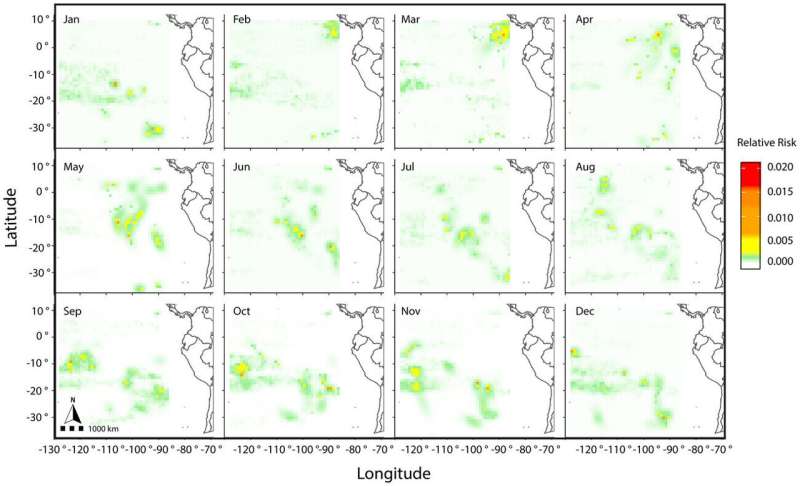This article has been reviewed according to Science X's editorial process and policies. Editors have highlighted the following attributes while ensuring the content's credibility:
fact-checked
peer-reviewed publication
proofread
Novel research takes marine conservation tools to a new dimension

In the new article "Incorporating multidimensional behavior into a risk management tool for a critically endangered and migratory species" published in Conservation Biology, researchers combined data on the diving behavior of East Pacific leatherbacks with data on fishing effort from Global Fishing Watch to enhance the South Pacific TurtleWatch (SPTW) dynamic ocean management tool.
Lead author and Upwell Researcher Nicole Barbour states, "The method we use is a novel example of how behavior and vertical movements, such as diving or flying, can be incorporated with fisheries data into risk and dynamic management tools for endangered, migratory species."
"We demonstrated this method on the critically endangered Eastern Pacific leatherback turtle but have additionally provided publicly available example code and models with our manuscript so that studies on other migratory species of conservation interest can adopt similar methods."
The critically endangered East Pacific leatherback sea turtle population is highly migratory and dives constantly (sometimes up to 1,200 meters) as it swims to forage, avoid predators, thermoregulate, and navigate.
In order to contemplate this vertical habitat use in protection strategies, researchers generated maps showing the relative risk of turtle-fisheries interactions based on data obtained from dive tags identifying three states of leatherback behavior (transiting, residential/mixed-depth diving, and residential/deep diving) and fishing effort data specific to gear type (longlines, trawl nets, gillnets, etc.) from Global Fishing Watch.
These maps were then added as new layers of information to the South Pacific TurtleWatch dynamic ocean management tool to refine its capability to provide predictions of potential high risk bycatch areas. The SPTW is a unique model created by scientists from Upwell and the University of Maryland Center for Environmental Science (UMCES), and other partners to empower fishers with the knowledge of where and when they are most likely to encounter leatherbacks in the Eastern Pacific Ocean with the aim of reducing the risk of incidental capture.
The application of the new and rich dataset on fishing effort from Global Fishing Watch was especially helpful to fill information gaps about the region's fisheries in the SPTW.
The article was a collaborative effort initiated by the international non-profit sea turtle research and conservation organization Upwell with partners from the University of Maryland Center for Environmental Science, MigraMar, SUNY College of Environmental and Forest Sciences, and Mercator Ocean International.
Upwell Executive Director Dr. George Shillinger reflected on the article's impact, saying, "We hope that our findings will spark a broader discussion about the urgency to leverage any and all credible data to better understand and mitigate the threats posed to leatherbacks by fisheries. The tool presents an opportunity to spark dialog about sea turtle conservation and to inform efforts to reduce fisheries impacts across the range, distribution, and life history of this critically endangered leatherback population."
More information: Nicole Barbour et al, Incorporating multidimensional behavior into a risk management tool for a critically endangered and migratory species, Conservation Biology (2023). DOI: 10.1111/cobi.14114
Journal information: Conservation Biology
Provided by Upwell




















